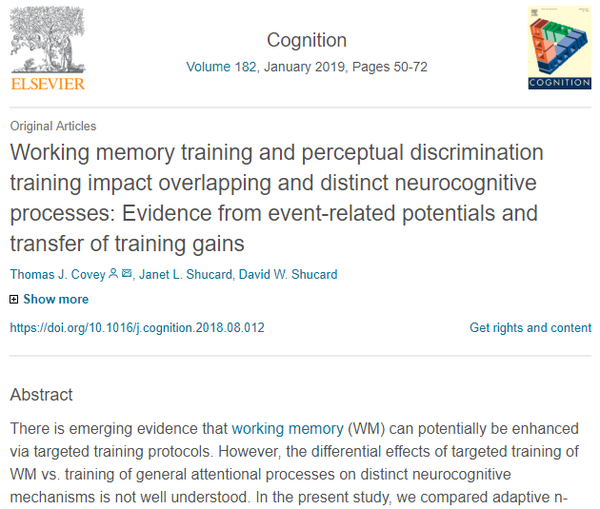Today I will look at:
- A summary of this latest study, showing beneficial brain training effects for a variety of different intelligence and attention control outcomes.
- An educational tutorial, reviewing certain key concepts in the cognitive neuroscience of brain training.
- A case for the critical role of interference control training in n-back training games.

Working memory: the ability to temporarily hold information or rules in your ‘mental workspace’ in the face of distractions or concurrent tasks, needed for all purposeful, intelligent problem solving, decision-making, comprehension or learning.
The n-back task used was not the classic n-back, but n-back demanding interference control such as implemented in the IQ Mindware apps
The N-Back Task
This is the most well-established working memory training task used by cognitive neuroscientists. It’s been applied in many, many applied contexts from IQ augmentation to self-control for addictions. You should know what it involves. In this study they used a letter matching n-back task – there are other varieties such as the visuo-spatial n-back and the dual n-back. Look at the example shown here from the paper.

Every two seconds a letter appears in the centre of the screen for half a second or so. You are shown 30 letters or so in total (only 5 are shown in here). In this 3-back example, you are looking for a matching letter from 3 letters earlier in time – in this case you can see there is a ‘match’ on the fifth letter in the sequence. To perform this task, you have to keep a kind of ‘running tally’ of the current letter that’s just been shown to you and 3 letters before it in order, dropping a letter each time as it leaves the 3-back ‘mental workspace’ for the task. For or the last two letters in the example above you may be saying quickly to yourself ‘r,t,g’…‘t,g,a’….as you see the ‘a’ and ‘T’ respectively. (This is called working memory updating.) Each time there is a 3-back match, you need to press a key pad.
This example below shows where there is no match – so you wouldn’t press a key for a match.


Search (Perceptual Discrimination) Training

You can see that ‘interference control’ is needed in both tasks. The key difference is that the n-back task needs your working memory, while the search task does not.
Training Task Improvement
First of all stating the obvious. Both groups got better at their training tasks, as shown in this graph of their performance. For those of you who feel like you are not making quick enough progress with your n-back training, take a close look. Each Session in this experiment is longer and is equivalent to 2 Sessions using IQ Mindware apps. You can see that training gains are slow and gradual, with some flat-lining along the way!
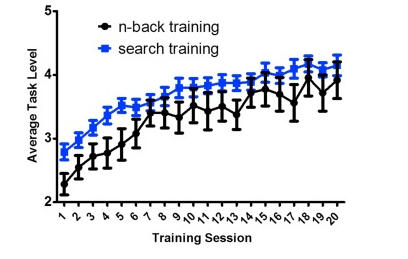
Transfer Benefits From The Brain Training
Near transfer is when training on one task (e.g. letter n-back) has benefits that transfer to a similar task (e.g. spatial n-back). Far transfer is when training on one task (e.g. n-back) has benefits that transfer to very different tasks (e.g. IQ test tasks) – so it’s not just a practice-effect for the same game.
Here’s an illustration of the near-far transfer concept for music training (work by Ewa Miendlarzewska).
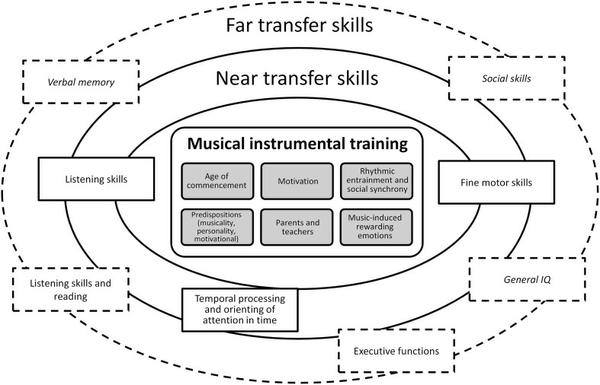
Another term you’ll come across when you listen to scientists discussing brain training is effect size. Effect sizes are measures of the training benefits in standardized scores which I will represent here as the equivalent number of points on a standardized IQ test.
Here are the graphs of the results for all measures. On the x axis you have pre-training and post-training measures; performance on the tests are given on the y axis. Blue is the search training group, black is the n-back group.
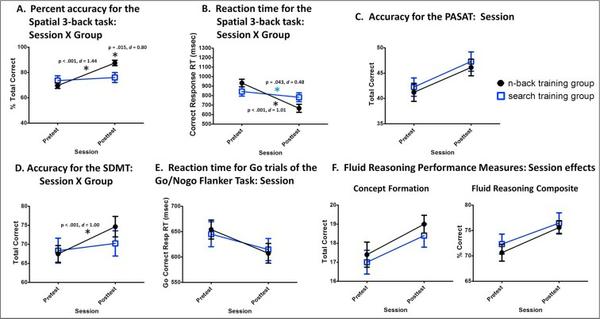
It turns out that both n-back and search training results in benefits, but in different ways.
Near Transfer Brain Training Benefits
Graphs A and B show performance on a spatial n-back task (a task many of you will be familiar with from the IQ Mindware apps). You can see that the n-back group – but not the search group – does better on both measures (accuracy and reaction time) with effect sizes of ~6 and 3 standardized points.
Medium Transfer Training Benefits
Graph C is performance on the PSAT (Paced Serial Addition Test). the PSAT is a measure of auditory information processing speed and flexibility, as well as calculation ability. Both training groups improve on this test significantly – a big 9.6 standardized points. Graph D is performance on the SDMT (Symbol Digit Modalities Test) – a measure of processing speed, and here only the the n-back group improve from the training – by 2.5 standardized points.
Far Transfer Training Benefits
Graph E is for a well-known attention control measure called the Go/No No task. Both n-back and search groups benefited from their brain training – 5.3 standardized points.
F shows two graphs for fluid intelligence (Gf) gains – concept formation, and an averaged (composite) measure of fluid intelligence (averaged over matrices, letter series, concept formation and ‘analysis-synthesis’ – a general test of inference-based problem solving). Interestingly, both groups benefited equally from training – 4.3 points for concept formation specifically, and over 6 points for overall fluid intelligence. As far as effect sizes for interventions go, this is an impressive effect size.
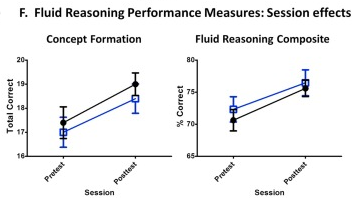
Covey and colleagues conclude:
“Pretest-to-posttest improvements in Gf and cognitive control performance were observed for both training groups. The effect sizes for these findings were also large.”
The research team also also measured the groups’ brain activity using EEG – electrodes placed on the scalp measuring the time course of electrical activity (brain waves) in different regions of the brain (color coded from positive to negative in the figure). Note that training effects are greater when there is need for interference control (with lure trials) – something built into IQ Mindware n-back training, but not most n-back training software.
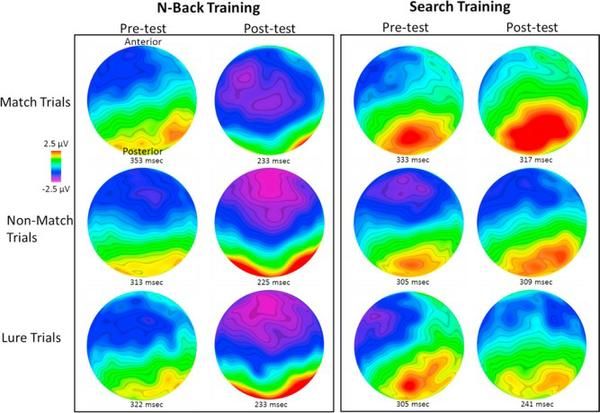
The EEG differences showed that the search training group showed earlier brainwave components “consistent with the view that search training produced a general improvement in the speed and efficiency of information processing(and also possibly selective attention), across multiple stages of information processing”. By contrast, the n-back training group showed brainwaves characteristic of monitoring for response options for information held in working memory. Exactly as you would expect based on our theoretical understanding of the processes.
So in summary, we have another exciting study showing the brain training benefits of the working memory and interference control training implemented in the IQ Mindware apps.
Reference
Covey, T. J., Shucard, J. L., & Shucard, D. W. (2019). Working memory training and perceptual discrimination training impact overlapping and distinct neurocognitive processes: Evidence from event-related potentials and transfer of training gains. Cognition, 182, 50–72. https://doi.org/10.1016/j.cognition.2018.08.012
